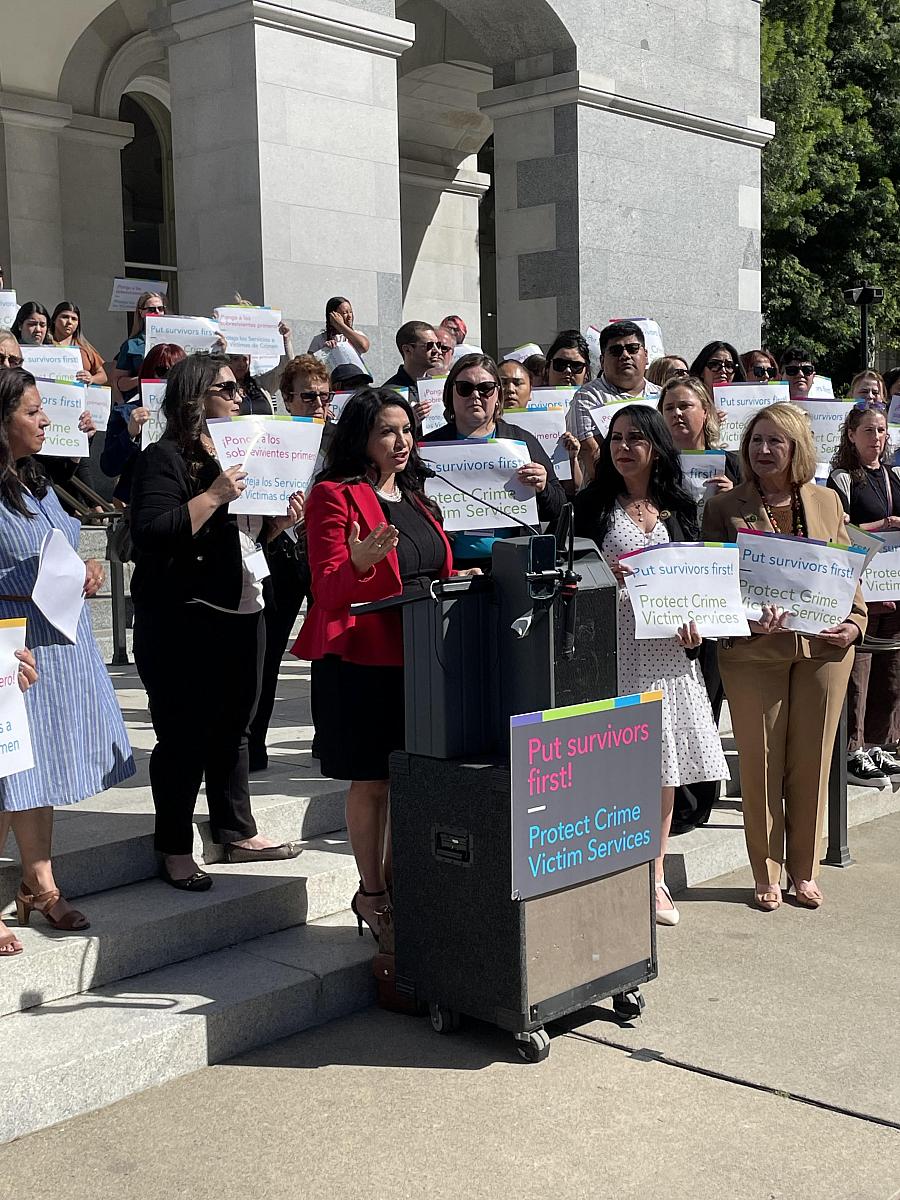What reporting about the intersection of domestic violence and homelessness taught me

California state Sen. Susan Rubio spoke to domestic violence and crime victim advocates at the California Capitol in late April to advocate for funding for crime victim services amid potentially devastating cuts.
(Photo by ValorUS)
For years I have been covering domestic violence as an issue that mostly happens because of a power imbalance in homes. I have seen how women have been forced to flee their homes in their attempt to escape abusers with nothing but the clothes on their back, some with their children in tow. But I didn’t realize that a good portion of the unhoused women on the streets of the Golden State were there after fleeing domestic violence.
The release of a report from the UCSF Benioff Homeless and Housing Initiative earlier this year brought that into focus for me. The report said that more than 181,000 people experienced homelessness on a single night in 2023 in California, and that thousands of women were in that situation because of the intimate partner violence they had experienced while housed. Those findings galvanized me to explore the situation in more detail. I am grateful to the Center for Health Journalism’s Domestic Violence Impact Fund for supporting my reporting on this.
I’m one of those reporters who like to sprinkle their stories with voices that people can relate to. Anecdotal stories are always more compelling to readers. But it would be weeks before I could find women who were willing to share their stories that supported the report’s findings. By that time, the findings had been reported extensively in media outlets in and outside of California.
So, I decided to widen the focus of my story and report on how new laws had been introduced in California that would make it easier for unhoused women, even those with poor credit and eviction histories — often the results of intimate partner violence — to find stable housing.
But it was more challenging than I thought. Being unhoused gave survivors no place to hide from their abusers, and going public with their stories could once again put them in harm’s way. As Dr. Margot Kushel, the co-author of the UCSF report, said during a webinar, “There are only so many places you can hide when you are vulnerable.”
And of course there was the shame factor most all survivors face. Chris Richardson, chief program officer of the 15-year-old San Jose nonprofit Downtown Streets Team, which provides supportive services and resource to people living outdoors or in temporary shelters, told me: “(Survivors) will talk about getting arrested, about prison time, but not about their domestic abuse, because there is a lot of stigma and shame around it.”
Richardson got the ball rolling for me. He put out an all points-bulletin to volunteers and staff members on his team and one survivor responded, Ariana Severs. Severs not only shared her story with me she also contacted a couple of other survivors in her network and persuaded them to talk to me. I also interviewed two other women who were willing to go public with their domestic violence experiences.
All the women I interviewed told me that they felt that by putting their stories out into the world they were empowering themselves. They said it helped them reclaim control of their own experiences. They believed that sort of control would help them to heal themselves of the hard-to-shake trauma they have been living with for years.
I learned a great deal from my reporting on this story, some of which I want to share so other reporters of domestic violence issues can avoid some of the mistakes I made and perhaps emulate what worked for me:
In reporting on domestic violence, I’d argue there is no harm in setting aside one of the journalistic principles we reporters rigidly hold on to — the belief that sources should not be allowed to review the draft of a story. Because of the sensitive nature of domestic violence, I sent my sources the parts of my recent story that related to them and asked them to check them for accuracy. It was a compromise, but one I felt did not take away from the ethical codes of journalism I try to embrace.
The above step had a two-fold purpose. By not challenging anything I had said in the draft of my story, the sources were in effect giving me “informed consent.” That consent not only protects the sources but the media outlet in which the story is going to run as well. It can help prevent legal repercussions that could arise at a later date.
- I let the source know early on that I was working on an investigative piece and that involves a deep dive into the issue. I also let them know that I would be interviewing many more survivors. That meant it could be weeks, even months before the story is published. In an oversight, I failed to do this with one unsavvy source, who accused me of ghosting her when weeks passed before I reconnected with her after I first interviewed her.
In the interest of objectivity, I try to project a demeanor of professional objectivity while interviewing my sources, (even if those interviews are conducted in their living room, sitting on a sink-in sofa). But at the same time, I do not hide from them the fact that I care deeply about their experience. Showing that side of me has always helped me in getting people to open up. And it has helped me expand my source pool.

